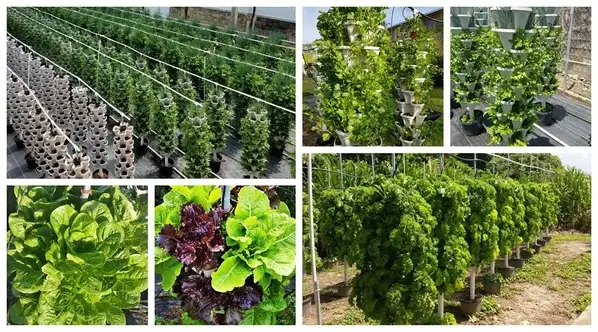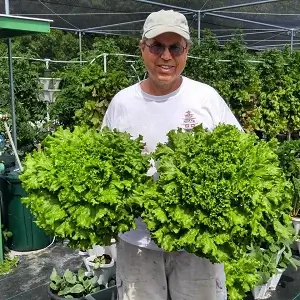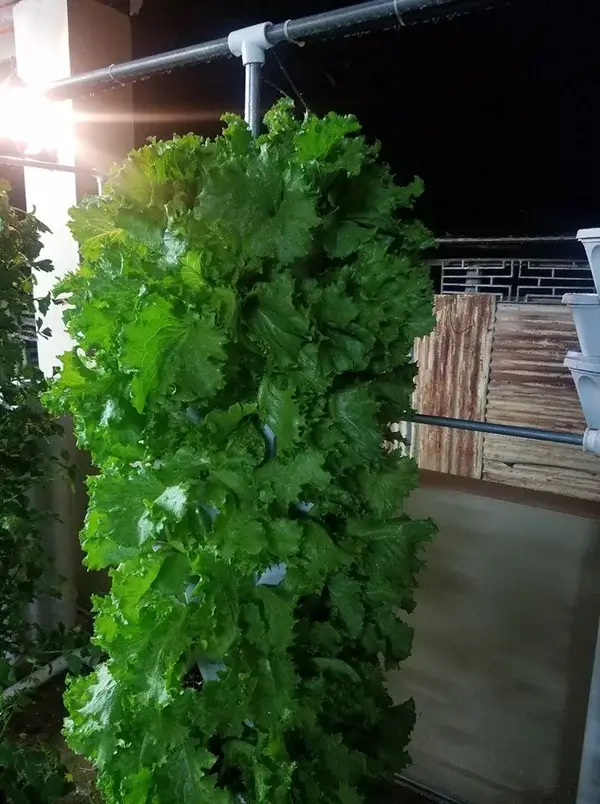Growing Hydroponic Lettuce
 Lettuce grown hydroponically in Mr Stacky Tower Gardens;
* Grows best in the cooler months
* Needs full sun during winter (min 4-6 hours p/day) and shaded sun during summer
* Should be continually planted at intervals of 3 weeks to ensure a continuous harvest
* Will be ready for harvest from 30 – 60 days from sowing (depending on the variety)
* Needs constant moisture
* Are very easy to grow and taste amazing!!!
Lettuce is a low-light, low-temperature crop. It is very fast growing and works very well with
hydroponics. You can expect a 40% increase in lettuce yield with hydroponics
over soil grown lettuce, but warning! Lettuce is not a tropical vegetable!
Nearly all problems you may encounter when growing lettuce are caused by hot weather. The most common problem is the plants bolting to seed prematurely. This happens especially if you get very hot weather after a cool spell.
The upper temperature to grow heading lettuces (ie. iceburg, cos/romaine, butter) is 28°C. Therefore, only attempt to grow these varieties during winter. During the summer months, stick to the loose leaf varieties.
Click here for a complete list of the types of lettuces available to grow.
Lettuce grown hydroponically in Mr Stacky Tower Gardens;
* Grows best in the cooler months
* Needs full sun during winter (min 4-6 hours p/day) and shaded sun during summer
* Should be continually planted at intervals of 3 weeks to ensure a continuous harvest
* Will be ready for harvest from 30 – 60 days from sowing (depending on the variety)
* Needs constant moisture
* Are very easy to grow and taste amazing!!!
Lettuce is a low-light, low-temperature crop. It is very fast growing and works very well with
hydroponics. You can expect a 40% increase in lettuce yield with hydroponics
over soil grown lettuce, but warning! Lettuce is not a tropical vegetable!
Nearly all problems you may encounter when growing lettuce are caused by hot weather. The most common problem is the plants bolting to seed prematurely. This happens especially if you get very hot weather after a cool spell.
The upper temperature to grow heading lettuces (ie. iceburg, cos/romaine, butter) is 28°C. Therefore, only attempt to grow these varieties during winter. During the summer months, stick to the loose leaf varieties.
Click here for a complete list of the types of lettuces available to grow.
 Set-up:
Set-up:
- Follow this simple guide to grow seedlings
- Sow at least 5-10 seeds per seedling cube. (You’ll later pinch off the weakest seedlings)
- For Cos and Iceburg varieties, pinch off the weakest seedlings leaving 1 seedling per mesh pot for best results. (These varieties need at least 7 inches between plants).
- For Loose leaf varieties, leave between 3 to 10 seedlings per mesh pot. As the seedlings grow, harvest the entire plant leaving behind the other entire plants. This way, you’re allowing 1 or 2 plants to fully mature in each pot.
- Place your lettuce in each of the Mr Stacky pockets
- Ensure the lettuce receives full sun in winter (min 4 hours direct sunlight) and in summer a maximum of 4 hours and preferably morning or afternoon light. Lettuce is a cool weather crop, so long days and hot summer temperatures can cause the crop to “bolt” or go to flower.
- The nutrient solution should not be too concentrated for lettuce. An EC of 1.2 – 1.9 is best.
- Within 1 week, you should start to see roots shooting out through the bottom of the mesh pot or seedling tray.
- The root systems of lettuce are shallow and do not require very much space. For this reason the medium planters are more than adequate for all varieties of lettuce.
 Maintenance:
Maintenance:
- The ideal water temperature for hydroponic lettuce is between 20 to 25 degrees celcius. If the water temperature gets too high, the nutrient solution will not hold enough dissolved oxygen, but if the temperature is too low, the metabolism of the roots is slowed down and plant growth can stall.
- Just a simple inspection for any creepy crawlies is all that’s needed every couple of days….
- Bugs that chew on your lettuce are often a symptom that your plant is not as happy as it could be. Bugs are attracted to stressed plants. You’ll notice that a healthy plant will simply not get attacked like an unhealthy plant will. A plant that is being attacked just tells you it’s not getting the right amounts of sunlight, water, nutrients or oxygen to the root zone.
- pH control is also important for hydroponic lettuce production. Good news is that with a drain to waste system, testing the PH often, is not as necessary. This is because you’re constantly giving fresh water, instead of recirculating systems.
- To test the PH is easy with any pool PH testing kit. A slightly acidic pH range of 5.8-6.4 is recommended, with 6.0 as a good target pH. If the pH is too high (alkaline), use a pH Lower solution containing a mild acid. If the pH is too acidic, use a pH Raise solution containing a mild base such as potassium
 Troubleshooting:
Problem: The edges of lettuce leaves turn brown and die back.
Diagnosis: Tip burn. Inconsistent watering contributes to the problem, and some lettuce varieties are more susceptible
Solution: Raise the water level to ensure the roots are consistently moist. Plant resistant varieties, including ‘Magenta’ and ‘Ermosa’,
a butterhead bred for heat tolerance.
Problem: Tiny green, white, or black insects are clustered on the underside of lettuce leaves.
Diagnosis: Aphids. These pests are a problem, especially when the weather is cool, because they emerge earlier and tolerate colder temperatures than many of their predators.
Solution: Use a natural insecticide such as Pyrethrum to control especially bad infestations, but before you spray, monitor the problem for a few days. During most times of the year, beneficial insects quickly control aphids. Encourage a robust population of aphid enemies by growing plants with nectar-rich flowers, including cilantro, dill, and sweet alyssum.
Problem: Your lettuce is shot through with tiny holes.
Diagnosis: Flea beetles
Solution: Install a row cover over your lettuce immediately after sowing or transplanting to exclude flea beetles from your crop. Row covers also help control thrips, leaf hoppers and aphids.
Problem: Your lettuce seedlings suddenly died.
Diagnosis: Damping-off, a soilborne fungal disease that thrives in cool, damp, cloudy conditions and kills seedlings
Solution: Space plants apart to provide good airflow and reduce watering.
Problem: Mature plants rot or collapse.
Diagnosis: Fungal disease, including bottom rot or sclerotinia drop.
Solution: If you live where cold, damp weather is normal during the lettuce-growing season, space plants farther apart to encourage good air circulation and reduce watering. Plant varieties that resist fungal disease, such as ‘Optima’.
Problem: Your lettuce tastes terrible.
Diagnosis: Your plants are old, bolting, or drought-stressed.
Solution: Bitterness naturally occurs in older lettuce plants, but it can occur in drought-stressed young plants. Taste-test your lettuce often. To prevent bitterness, keep the soil evenly moist and harvest plants before they begin to form a conical head.
Thanks for reading. For those who want a simple and incredibly effective method to grow abundant quantities of quality lettuce, this 72 plant 3 tower system can be set-up in any small space!
Troubleshooting:
Problem: The edges of lettuce leaves turn brown and die back.
Diagnosis: Tip burn. Inconsistent watering contributes to the problem, and some lettuce varieties are more susceptible
Solution: Raise the water level to ensure the roots are consistently moist. Plant resistant varieties, including ‘Magenta’ and ‘Ermosa’,
a butterhead bred for heat tolerance.
Problem: Tiny green, white, or black insects are clustered on the underside of lettuce leaves.
Diagnosis: Aphids. These pests are a problem, especially when the weather is cool, because they emerge earlier and tolerate colder temperatures than many of their predators.
Solution: Use a natural insecticide such as Pyrethrum to control especially bad infestations, but before you spray, monitor the problem for a few days. During most times of the year, beneficial insects quickly control aphids. Encourage a robust population of aphid enemies by growing plants with nectar-rich flowers, including cilantro, dill, and sweet alyssum.
Problem: Your lettuce is shot through with tiny holes.
Diagnosis: Flea beetles
Solution: Install a row cover over your lettuce immediately after sowing or transplanting to exclude flea beetles from your crop. Row covers also help control thrips, leaf hoppers and aphids.
Problem: Your lettuce seedlings suddenly died.
Diagnosis: Damping-off, a soilborne fungal disease that thrives in cool, damp, cloudy conditions and kills seedlings
Solution: Space plants apart to provide good airflow and reduce watering.
Problem: Mature plants rot or collapse.
Diagnosis: Fungal disease, including bottom rot or sclerotinia drop.
Solution: If you live where cold, damp weather is normal during the lettuce-growing season, space plants farther apart to encourage good air circulation and reduce watering. Plant varieties that resist fungal disease, such as ‘Optima’.
Problem: Your lettuce tastes terrible.
Diagnosis: Your plants are old, bolting, or drought-stressed.
Solution: Bitterness naturally occurs in older lettuce plants, but it can occur in drought-stressed young plants. Taste-test your lettuce often. To prevent bitterness, keep the soil evenly moist and harvest plants before they begin to form a conical head.
Thanks for reading. For those who want a simple and incredibly effective method to grow abundant quantities of quality lettuce, this 72 plant 3 tower system can be set-up in any small space!


About the Author
Mr Stacky is the leader in Tower Garden Systems in Australia, specializing in commercial hydroponic farming, urban farming & residential vertical gardening.
Find out how he can help you achieve your food production goals. Contact Brian
